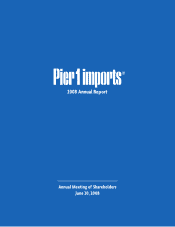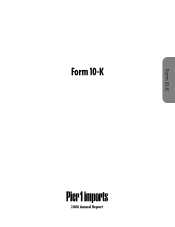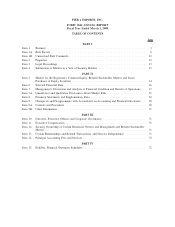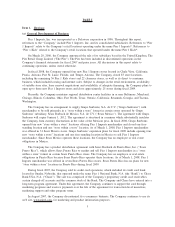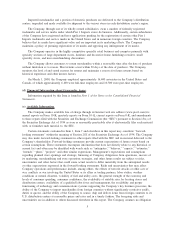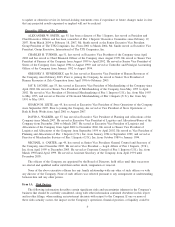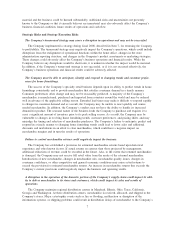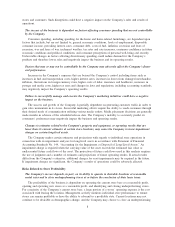Pier 1 2008 Annual Report Download - page 11
Download and view the complete annual report
Please find page 11 of the 2008 Pier 1 annual report below. You can navigate through the pages in the report by either clicking on the pages listed below, or by using the keyword search tool below to find specific information within the annual report.store before its lease expires and incur lease termination costs associated with that closing. The Company
cannot give assurance that a reduction in openings or increase in closings will result in greater profits.
Failure to attract and retain an effective management team or changes in the costs or availability of a
suitable workforce to manage and support the Company’s stores and distribution facilities could adversely
affect the business.
The Company’s success is dependent, in a large part, on being able to successfully attract, motivate and
retain a qualified management team and employees. Sourcing qualified candidates to fill important positions
within the Company, especially management, in the highly competitive retail environment may prove to be a
challenge. The inability to recruit and retain such individuals could result in turnover in the stores and the
distribution facilities, which could have an adverse effect on the business. Management will continue to assess
the Company’s compensation and benefit structure in an effort to attract future qualified candidates or retain
current experienced management team members.
Occasionally the Company experiences union organizing activities in its non-unionized distribution
facilities. These types of activities may result in work slowdowns or stoppages and higher labor costs. Any
increase in costs associated with labor organization at the distribution facilities could result in higher costs to
distribute inventory and could negatively impact merchandise margins.
Factors affecting the general strength of the economy in periods of decline could result in reduced con-
sumer demand for the Company’s products.
The Company’s successful execution relies on customer demand for its merchandise, which is affected by
factors that are impacted by prevailing economic conditions. A general slowdown in the United States
economy, adverse trends in consumers’ ability to borrow money, and an uncertain economic outlook may
adversely affect consumer spending which in turn could result in lower sales and unfavorable operating results.
A prolonged economic downturn could have a material adverse effect on the business, and its financial
condition and results of operations.
The Company operates in a highly competitive retail environment with companies offering similar mer-
chandise, and if customers are lost to the Company’s competitors, sales could decline.
The Company’s retail locations operate in the highly competitive specialty retail business competing with
specialty sections of large department stores, home furnishing stores, small specialty stores and mass
merchandising discounters. Management believes that in addition to competing for sales, it competes on the
basis of pricing and quality of products, constantly changing merchandise assortment, visual presentation of its
merchandise and customer service. The Company could also experience added short-term competition when
other retailers are liquidating merchandise for various reasons. The level of competition is not anticipated to
decrease and if the Company is unable to maintain a competitive position, it could experience negative
pressure on retail prices and loss of customers, which in turn could result in reduced merchandise margins and
operating results.
The Company’s business is subject to seasonal variations, with a significant portion of its sales and earn-
ings occurring during two months of the year.
Approximately 25% of the Company’s sales generally occur during the November-December holiday
selling season. Failure to predict consumer demand correctly during these months could result in lost sales or
gross margin erosion if merchandise must be marked down to clear inventory.
The Company’s business may be harmed by adverse weather conditions and natural disasters.
Extreme or undesirable weather can affect customer traffic in retail stores as well as customer shopping
behavior. Natural disasters such as earthquakes, weather phenomena, and events causing infrastructure failures
could adversely affect any of the Company’s retail locations, distribution centers, administrative facilities,
ports, or locations of its suppliers domestically and in foreign countries.
9

